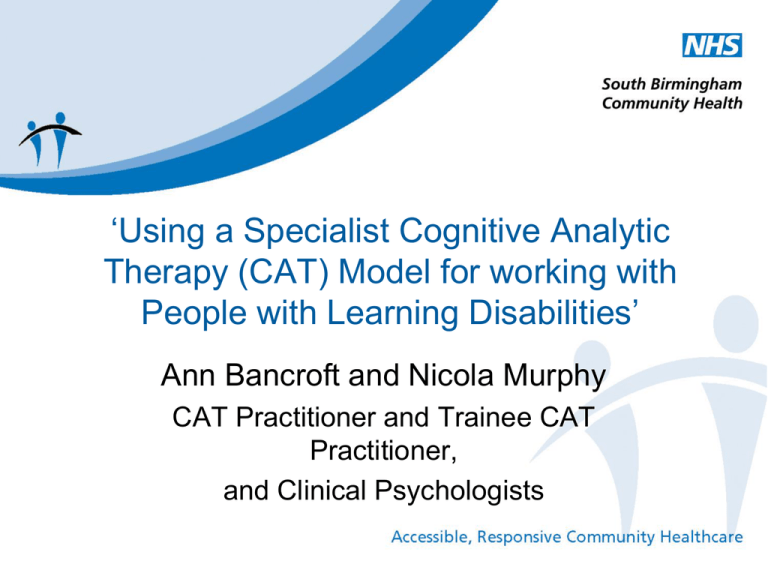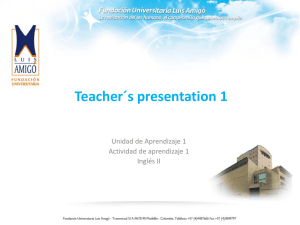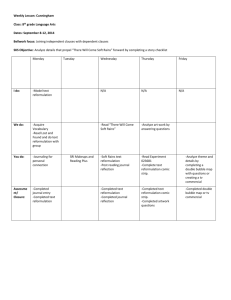CAT Model for Learning Disabilities: A Specialist Approach
advertisement

‘Using a Specialist Cognitive Analytic Therapy (CAT) Model for working with People with Learning Disabilities’ Ann Bancroft and Nicola Murphy CAT Practitioner and Trainee CAT Practitioner, and Clinical Psychologists Overview • The CAT Model • Suitability of the Cognitive Analytic Therapy (CAT) model for working with People with Learning Disabilities (PLD) • Specialising the model for PLD • Applications of CAT in PLD Services • Case example • Summary and Questions Cognitive Analytic Therapy (CAT) (i) • Well-researched, flexible and effective psychotherapy used with a range of client groups • Based on social model of ‘The Self’ • Key idea is that both poles of adult to child ‘Reciprocal Roles’ experienced during early relationships, become internalised, and form the basis of personality and self-management procedures. Cognitive Analytic Therapy (CAT) (ii) • Key features - time-limitation, collaboration, and the active use of the therapeutic relationship. • Aim - to identify, recognise and revise procedural sequences (patterns of thoughts, feelings and behaviours) that have become problematic/unhelpful. • Increasing diversification of use, including indirect work & working with teams Standard CAT Therapy • Individual therapy • Fixed sessions – 16, (and 8, 24, 32) • Standard process – – – – reformulation phase recognition and revision phase ending follow-up Standard CAT (i) Reformulation phase Identification of target problem procedures – traps, dilemmas & snags TRAPS ‘things we cannot escape from….. vicious circles … trying to deal with feeling bad about ourselves, we think and act in ways that tend to confirm our badness’ self-fulfilling prophecies Standard CAT (ii) Reformulation phase DILEMMAS ‘False choices and narrow options …. If I do ‘x’ then ‘y’ will follow …. Either/or or If/then dilemmas’ polarised choices – no middle ground black and white thinking SNAGS “….when we say “I want to have a better life, or I want to change my behaviour but…” Hitches/ self-sabotages things that get in the way Standard CAT (iii) Reformulation phase • Target problem procedures for therapy agreed • Written and diagrammatic reformulation Standard CAT (iv) Recognition & revision phase Oops I’m doing it again! • Aim is to recognise recurrences of target problem procedures • Therapist encourages client to make active use of reformulation tools (letter & diagrams) to help recognise repetition of unhelpful patterns in client’s daily life, and within therapy sessions Standard CAT (v) Recognition & revision phase Oops I’m doing it again! I could do something different! • Once recognition is achieved then client and therapist work together to develop new, more helpful procedures • These are added to the diagrammatic reformulation as ‘Exits’ or ‘Ways Out’ Standard CAT (vi) Ending Phase & Follow Up • Aim is to achieve a ‘good’ and ‘planned’ ending • Exchange of Goodbye Letters • Follow up session to review progress Suitability of CAT for PLD (i) • Flexible framework • Emphasis on collaboration and boundaries • Use of ‘Zone of Proximal Development (ZPD) • Use of written and diagrammatic materials to supplement verbal communication Suitability of CAT for PLD (ii) • Practical therapeutic tools • Provides a vehicle for addressing fundamental Learning Disability Issues in a safe environment • Can be modified according to client need without losing essential elements of the model Specialised CAT for PLD (i) Modifications to the course of therapy – Pre-Reformulation period to establish relationship – Collaborative completion of Psychotherapy File within sessions – Adaptation of pace of therapy – e.g. Length, frequency and number of sessions – Adaptation of goals of therapy – sometimes ‘Recognition’ is the most appropriate goal – Collaborative development of goodbye letters &/or the story of the therapeutic journey Specialised CAT for PLD (ii) Modifications to therapeutic tools – Use of simplified language as appropriate – Adapted Psychotherapy File – simplified language version (King, 2005), diagrammatic version (Bancroft, 2009) – Pictorial/Symbolised diaries, rating scales, letters – Audio-recorded therapy letters – Creative methods, role play, story work, emotion symbols From this ..... ‘Fear of hurting others’ Trap, Psychotherapy File 2009 updated version Feeling fearful of hurting others we keep our feelings inside, or put our own needs aside. This tends to allow other people to ignore or abuse us in various ways, which then leads to our feeling, or being, childishly angry. When we see ourselves behaving like this, it confirms our belief that we shouldn’t be angry or aggressive and reinforces our avoidance of standing up for our rights. ++ + 0 To this ...... ‘Fear of hurting others’ Trap, Simplified Version Are you afraid of hurting other people’s feelings? yes/no If yes Do you hide your feelings and needs inside when you are with other people? yes/no Or this .... YES SOMETIMES NO Upset Feelings Dilemma 2009 updated version Either I keep feelings bottled up or I risk being rejected, hurting others, or making a mess. + ++ 0 Upset feelings Dilemma simplified words version I must keep my feelings inside of me. If I do not, other people will not like me. Yes/no Upset feelings Dilemma My version for people with LD YES SOMETIMES NO Snags 2009 updated version Do you recognise that you feel limited in your life: 1. for fear on the response of others: e.g. I must sabotage success, for example 1) as if it deprives others, 2) as if others may envy me or 3) as if there are not enough good things to go around + ++ 0 2. by something inside yourself: e.g. I must sabotage good things as if I don’t deserve them. + ++ 0 Snags simplified words version Do you ever feel that you are stopped from doing good things or having good things because you are afraid of what other people might say or do? yes/no Do you ever feel that you are stopped from doing good things or having good things by something inside of yourself telling you that you are not good enough to have them? yes/no SNAGS – things that get in the way My version for people with LD I want to …. But… Applications of CAT in PLD Services (i) • • • • • • Individual Therapy Group Work Working with carers and staff teams Staff Training Supervision Consultancy Applications of CAT in PLD Services (ii) Group Work Add relational element to traditional group work- e.g. Self-esteem, Angermanagement Encouraging both participants and facilitators to be more aware of Reciprocal Roles in both the content and the process of the group work Applications of CAT in PLD Services (ii) Indirect Work A questioning relational approach: 1. How did you feel? • What did this make you want to do? • What did you do? • What did they do? • What happened then? • How did you feel? Applications of CAT in PLD Services (iii) 2. How do you think they were feeling? • What do you think they wanted you to do? • What did they do? • What did you do? • What happened then? • How do you think they were feeling? Indirect Work (iii) Identification of Reciprocal Roles and unhelpful procedures/patterns of behaviour Recognition of repetitions of these Revision – development of more helpful Reciprocal Roles and procedures Summary and Conclusions (i) • CAT is a useful model for working with People with Learning Disabilities • Flexible framework allows for Specialisation, modifications and adaptations according to individual client need without losing the essential essence of CAT Summary and Conclusions (ii) • The model can be used for all aspects of LD work – direct work with individuals, group work, work with carers and professionals, staff training and in consultancy and supervision Your turn Any questions? References (i) Bancroft, A., Collins, S., Crowley, V., Harding, C., Kim, Y., Lloyd. J., Murphy (2008). ‘Is CAT an island or a solar system? The dilemmas in the therapeutic frame when working with people with learning disabilities’. Summer edition, Reformulation Carradice, A (2004). Applying cognitive analytic therapy to guide indirect working. Reformulation Conference Paper, 1623. Clayton, P. (2006). “The learning disabled offender and the secure institution”. In P. Pollock, M. Stowell-Smith & M. Gopfert (Eds.), Cognitive Analytic Therapy for Offenders: A new approach to forensic psychotherapy. London: Routledge Clayton, P. (2001). Using cognitive analytic therapy in an institution to understand & help both client & staff. In Landsberg, G & Smiley, A (Ed.) Forensic Mental Health. USA: Civic Research Institute, Inc. References (ii) Collins, S. (2006). ‘Don’t dis me! Working with young people who have physical and learning disabilities.’ Winter Edition, Reformulation. David, C. (2009). “CAT and people with learning disability: Using CAT with a 17 year old girl with learning disability.” Reformulation 32 (Summer) p21-25. Fisher, C., & Harding, C. (2009). ‘Thoughts on the rebel role: Its application to challenging behaviour in learning disability services.” Reformulation, 32 (Summer) p4-5. King, Ros. (2005). ‘CAT and the therapeutic relationship and working with people with learning disability.’ Summer Edition Reformulation Lloyd, J. (2007). ‘Case Study on Z; Not as impossible as we had thought.’ Summer Edition, Reformulation References (iii) •Lloyd, J. & Williams, B. (2003). Reciprocal roles and the unspeakable known: Exploring CAT within services for people with learning disabilities. Summer Edition, Reformulation. •Lloyd, J. & Williams, B. (2003). ‘Exploring the use of Cognitive Analytic Therapy within services for people with learning disabilities and challenging behaviour.’ J. Lloyd and B. Williams (2004) Clinical Psychology and People with Learning Disabilities 2(2) 4-5. •Moss, A. (2007). ‘The application of CAT to working with people with learning disabilities.’ Summer Edition Reformulation •Murphy, N. (2008) ‘CAT used therapeutically and contextually for a client with learning disability and Asperger Syndrome.’ Summer Edition Reformulation. References (iv) •Murphy, N. (2008) ‘CAT used therapeutically and contextually for a client with learning disability and Asperger Syndrome.’ Summer Edition Reformulation. •Psaila, K. and Crowley, V. (2006). Cognitive Analytic Therapy in people with learning disabilities; An investigation of the common reciprocal roles found within the client group.’ Winter Edition. Reformulation. •Walsh, S. (1996). Adapting Cognitive Analytic Therapy to make sense of psychologically harmful work environments. British Journal of Medical Psychology, 69: 3-20.







